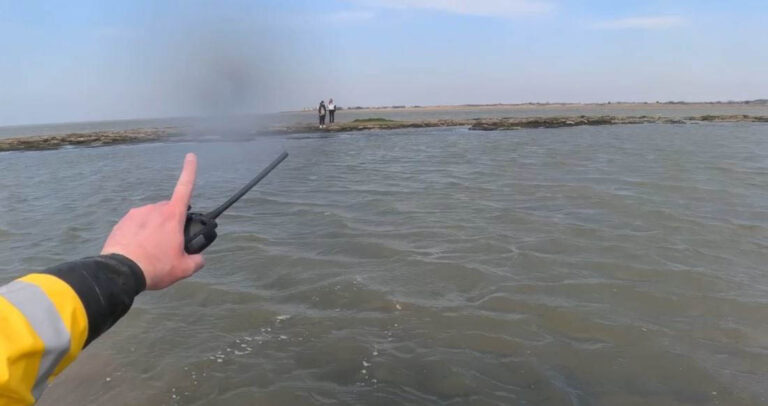New research reveals gaps in tidal knowledge that has led to 15% of British and Irish residents – 10 million people – in danger of being cut off by the tide.
As families head to the coast to enjoy the Easter school break, the RNLI has revealed the results of a survey with Bangor University2 which shows large gaps in tidal knowledge.
The findings of the nationwide research3 revealed that around 15% of respondents report being cut off by the tide, or nearly cut off, in their lifetime which equates to 10 million people in the UK and Ireland. Many of those people didn’t intend to be in or near the water. This gap in coastal safety knowledge is especially worrying as high spring tides will occur across the country during the Easter break when beaches are busy.
One of the key findings of the survey was the level of surprise about the speed of the incoming tide. Around 60% of those who had experienced tidal cut off were shocked at the speed they had become stranded.
The research also showed that four in ten people have no basic understanding of the tides and only half claim to check tide times before visiting a beach.
It further reveals that only a quarter (24%) of the public have sufficient ability to read and interpret a tide timetable in order to take the appropriate action to prevent being cut off by the tide.
RNLI rescue data shows that lifeboat crews and lifeguards responded to 7,971 incidents involving people cut off by the tide over the last decade. Of those incidents, many were considered life-threatening, and 452 lives were saved**.
Ensuring that you understand the tide times is vital before heading to the coast, as Yvonne from North Yorkshire, found out last summer when she was rescued by Fleetwood Lifeboat Station.
Yvonne and her family were visiting Fleetwood beach for the first time with a large group including her daughter, her daughter’s boyfriend and his little brother and their dogs. They had previously checked the tide times, but they weren’t aware that high tide times were different to low tide times.
They headed down to the sea but once they got to the shore, they could see it was too deep so started heading back in. They could see people on the other side of the water waving them back in, including a lifeguard, but the rockpools they had walked past on the way out were now knee-deep, they had been cut off by the tide.
Yvonne said: ‘Suddenly, the water was getting towards waist height. My partner, who had just had a shoulder replacement, got separated from us and was stood on a sand embankment. Within two minutes, all the sand was gone.
‘My phone got wet and I couldn’t make any calls for help but I knew a lifeguard had seen us. I had to stay strong for my whole family. The water got deep so suddenly we were almost swimming in it.
‘We started getting separated and further away from each other which was making my daughter panic, it was terrifying. Then we saw the lifeboat, I told everyone to stay calm and tread water whilst the crew came to rescue us.
‘I’ve since been back to thank the crew with some cakes. If they hadn’t come out, I don’t think it would have been the outcome we ended up with. The water was so fast. I don’t think we would have survived.’
As part of the research, Bangor University’s Impact and Innovation Fund commissioned a team including a marine social scientist, an ocean scientist and a discourse analyst to unpick people’s awareness of tides through a nationally representative survey and speaking with casualties. The research was carried out with a view to improving tidal knowledge through new public campaigns and education.
The RNLI is urging people to use a trusted online source such as the Met Office before setting off on a trip. Coastal visitors should be aware the water may change quickly and very differently to what may be expected. The tide comes in and out twice in each 24-hour period, and while tide times can be accurately predicted, they vary at each location and change each day. This is as important for coastal walkers to be aware of as it is for beach goers.
Chris Cousens, Water Safety Lead at the RNLI said: ‘The results of the survey are eye opening and show that a large proportion of the public have gaps in tidal knowledge.
‘We know there is a lot more work to be done. We will be using the findings to help shape our safety messaging in public campaigns and education going forward.
‘We expect this weekend to be busy on the coast, but with high spring tides forecast, areas affected by tidal cut off may be cut off faster than normal, and areas not normally known for tidal cut off may see incidents in the coming days.
‘Anyone heading to the coast is reminded of the importance of staying safe and checking the weather and tide times. If you can’t interpret the tide timetable, always seek local advice and stay alert.
‘It’s hard to imagine how walking can turn out to be such a dangerous activity, this is why it’s important to always check the tide times at the start of your day, keep an eye out for the incoming tide and leave enough time to return safely.’
Dr Liz Morris-Webb, Honorary Research Fellow at Bangor University said: ‘As a marine researcher with 25 years of experience along the British coast, I have seen many instances of people being caught out by the tide, from the public to experienced marine professionals. As so many people enjoy the benefits our coast has to offer, it is maybe not surprising that 15% of the population has at some point been cut off by the tide, or nearly so.
‘The first-hand experiences of those who have been cut off have provided important lessons on gaps in tidal knowledge that can quickly turn a family walk or beach visit into to life-threatening situation. I am very grateful to all those who have spoken to us about their traumatic experiences. Their participation is paving the way for improving safety messaging and driving a conversation about how to safely visit our beautiful, but wild, coast.’
When visiting the coast, always remember:
- Check the tide times. If you don’t understand them, please check local advice
- Choose a lifeguarded beach and swim between the red and yellow flags
- If you get into trouble in the water, Float to Live; tilt your head back with ears submerged and try to relax and control your breathing. Use your hands to help you stay afloat and then call for help or swim to safety if you can. It’s OK if your legs sink, we all float differently.
- In a coastal emergency, call 999 and ask for the Coastguard







